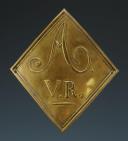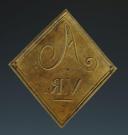
INFANTRY SHAKO PLATE FROM THE MILITIA OF THE CANTON OF APPENZELL AUSSERRHODEN, Early 19th century. 11986
SHAKO PLATE OF INFANTRY FROM THE MILITIA OF THE CANTON OF APPENZELL RHODES-EXTÉRIEURES, Early 19th century. 11986
Stamped brass plate in a diamond shape, H 11.1 cm, width 9.9 cm, bordered by a double molded relief strip with the letters "A. V. R." stamped in relief in the center.
Perfect condition.
Switzerland.
Early 19th century.
NOTE:
During the French Revolution, Switzerland raised military companies in Zurich, Glatt, Valais, Schwyz, and Appenzell-Rhodes Extérieures, the latter consisting of 431 men, but the canton would be occupied by the French.
HISTORY OF THE CANTON:
The canton of Appenzell Rhodes-Extérieures derives its name from the former canton of Appenzell from which it originated. Appenzell, the village that gave its name to the country, is mentioned for the first time in 1071 as Abbacella, then in 1223 as Abbatiscella, and finally as Abtenzelle, meaning "the retreat of the abbot," referring to a secondary residence of the abbot of Saint Gall.
The canton of Appenzell was divided into "rhodes," subdivisions that played a judicial and economic role. When the canton was split into two half-cantons in 1597, Appenzell Rhodes-Extérieures was formed from the six rhodes of the former Trogen bailiwick, predominantly Protestant.
In German, the official language of the canton, it is called Appenzell Ausserrhoden; in Italian, Appenzello Esterno; in Romansh, Appenzell Dador.
The Appenzell region began to be colonized in the 7th century along the Glatt River. The monastery of St. Gall greatly influenced the lives of the local population. Herisau is first mentioned in 907. The name Appenzell appears in 1071.
The canton has seen a number of battles over the centuries, including the Battle of Vögelinsegg in 1403 and the Battle of Stoss in 1405.
In 1513, Appenzell joined the Old Swiss Confederation as the 13th canton. In 1597, the canton was divided for religious reasons into two half-cantons: Appenzell Rhodes-Extérieures was the Protestant part, and Appenzell Rhodes-Intérieures the Catholic part.
Between 1798 and 1803, during the Helvetic Republic, the canton was integrated into the Canton of Säntis. It was reinstated after the Act of Mediation.
The first cantonal constitution was adopted in 1834 and amended in 1876 and 1906. The construction of numerous railway lines between 1875 and 1913 supported the local industry; the canton's population peaked in 1910 with 57,973 inhabitants (compared to 53,200 inhabitants in 2001).
In 1934, Johannes Baumann became the first citizen of Appenzell Rhodes-Extérieures to become a federal councilor. Women's right to vote and eligibility was introduced locally in 1972, but only in 1989 at the cantonal level; two women were first elected to the government in 1994. The Landsgemeinde was abolished in 1997.
CANTON'S COAT OF ARMS:
Its coat of arms depicts the bear of the monk Saint Gall, who founded the Canton of Saint Gall and a residence in Appenzell.
Appenzell means "the abbot's residence."
A legend tells that he met a bear and told it to bring him wood and then leave.
On the coat of arms, VR stands for "Usser Rhoden" (Rhodes-Extérieures).
Stamped brass plate in a diamond shape, H 11.1 cm, width 9.9 cm, bordered by a double molded relief strip with the letters "A. V. R." stamped in relief in the center.
Perfect condition.
Switzerland.
Early 19th century.
NOTE:
During the French Revolution, Switzerland raised military companies in Zurich, Glatt, Valais, Schwyz, and Appenzell-Rhodes Extérieures, the latter consisting of 431 men, but the canton would be occupied by the French.
HISTORY OF THE CANTON:
The canton of Appenzell Rhodes-Extérieures derives its name from the former canton of Appenzell from which it originated. Appenzell, the village that gave its name to the country, is mentioned for the first time in 1071 as Abbacella, then in 1223 as Abbatiscella, and finally as Abtenzelle, meaning "the retreat of the abbot," referring to a secondary residence of the abbot of Saint Gall.
The canton of Appenzell was divided into "rhodes," subdivisions that played a judicial and economic role. When the canton was split into two half-cantons in 1597, Appenzell Rhodes-Extérieures was formed from the six rhodes of the former Trogen bailiwick, predominantly Protestant.
In German, the official language of the canton, it is called Appenzell Ausserrhoden; in Italian, Appenzello Esterno; in Romansh, Appenzell Dador.
The Appenzell region began to be colonized in the 7th century along the Glatt River. The monastery of St. Gall greatly influenced the lives of the local population. Herisau is first mentioned in 907. The name Appenzell appears in 1071.
The canton has seen a number of battles over the centuries, including the Battle of Vögelinsegg in 1403 and the Battle of Stoss in 1405.
In 1513, Appenzell joined the Old Swiss Confederation as the 13th canton. In 1597, the canton was divided for religious reasons into two half-cantons: Appenzell Rhodes-Extérieures was the Protestant part, and Appenzell Rhodes-Intérieures the Catholic part.
Between 1798 and 1803, during the Helvetic Republic, the canton was integrated into the Canton of Säntis. It was reinstated after the Act of Mediation.
The first cantonal constitution was adopted in 1834 and amended in 1876 and 1906. The construction of numerous railway lines between 1875 and 1913 supported the local industry; the canton's population peaked in 1910 with 57,973 inhabitants (compared to 53,200 inhabitants in 2001).
In 1934, Johannes Baumann became the first citizen of Appenzell Rhodes-Extérieures to become a federal councilor. Women's right to vote and eligibility was introduced locally in 1972, but only in 1989 at the cantonal level; two women were first elected to the government in 1994. The Landsgemeinde was abolished in 1997.
CANTON'S COAT OF ARMS:
Its coat of arms depicts the bear of the monk Saint Gall, who founded the Canton of Saint Gall and a residence in Appenzell.
Appenzell means "the abbot's residence."
A legend tells that he met a bear and told it to bring him wood and then leave.
On the coat of arms, VR stands for "Usser Rhoden" (Rhodes-Extérieures).
Price :
200,00 €
| Destination | Envoi recommandé | Envoi Recommandé + Express |
|---|---|---|
| Shipping France | 9,00 € | 30,00 € |
| Shipping Europe | 17,00 € | 50,00 € |
| Shipping world | 30,00 € | 70,00 € |
Insurance (1%) :
2,00 €
Reference :
11986

Next update Friday, december 19 at 13:30 PM
FOR ALL PURCHASES, PAYMENT IN MULTIPLE CHECKS POSSIBLE
bertrand.malvaux@wanadoo.fr 06 07 75 74 63
SHIPPING COSTS
Shipping costs are calculated only once per order for one or more items, all shipments are sent via registered mail, as this is the only way to have proof of dispatch and receipt.
For parcels whose value cannot be insured by the Post, shipments are entrusted to DHL or Fedex with real value insured, the service is of high quality but the cost is higher.
RETURN POLICY
Items can be returned within 8 days of receipt. They must be returned by registered mail at the sender's expense, in their original packaging, and in their original condition.
AUTHENTICITY
The selection of items offered on this site allows me to guarantee the authenticity of each piece described here, all items offered are guaranteed to be period and authentic, unless otherwise noted or restricted in the description.
An authenticity certificate of the item including the description published on the site, the period, the sale price, accompanied by one or more color photographs is automatically provided for any item priced over 130 euros. Below this price, each certificate is charged 5 euros.
Only items sold by me are subject to an authenticity certificate, I do not provide any expert reports for items sold by third parties (colleagues or collectors).
FOR ALL PURCHASES, PAYMENT IN MULTIPLE CHECKS POSSIBLE
bertrand.malvaux@wanadoo.fr 06 07 75 74 63
An authenticity certificate of the item including the description published on the site, the period, the sale price, accompanied by one or more color photographs is automatically provided for any item priced over 130 euros. Below this price, each certificate is charged 5 euros.
Only items sold by me are subject to an authenticity certificate, I do not provide any expert reports for items sold by third parties (colleagues or collectors).

